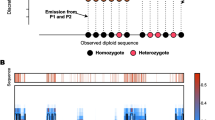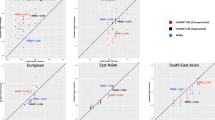Abstract
The genetic admixture is a dynamic and diachronic process, taking place during a great number of generations. Consequently, a sole admixture rate does not represent such an event and several estimates could help to take into account its dynamics. We developed an Admixture Indicative Interval (AII) which gives a mathematical key to avoid this problem by integrating several admixture estimators and their respective accuracy into a single metric and provides a trend in genetic admixture. To illustrate AIIs interests in admixture studies, AII were calculated using seven estimators on two sets of simulated SNPs data generated under two different admixture scenarios and were then calculated from several published admixed population data: a Comorian population and several Puerto-Rican and Colombian populations for recent admixture events as well as European populations representing the Neolithic/Paleolithic admixture for an older event. Our method provides intervals taking properly the variability and accuracy of admixture estimates into account. The AII lays in the intuitive interval in all actual and simulated datasets and is not biased by divergent points by the mean of a double-weighting step. The great quantity of heterogeneous parental contributions is synthesized by a few AII, which turn out to be more manageable and meaningful than aplenty variable point estimates. This offers an improvement in admixture study, allowing a better understanding of migratory flows. Furthermore, it offers a better assessment of admixture than the arithmetic mean, and enhances comparisons between regions, samples, and between studies on same population.

Similar content being viewed by others
References
Belle E, Landry PA, Barbujani G (2006) Origins and evolution of the Europeans’ genome: evidence from multiple microsatellite loci. Proc Biol Sci 273(1594):1595–1602
Bertorelle G, Excoffier L (1998) Inferring admixture proportions from molecular data. Mol Biol Evol 15(10):1298–1311
Bertoni B, Budowle B, Sans M, Barton S, Chakraborty R (2003) Admixture in Hispanics: distribution of ancestral population contributions in the Continental United States. Hum Biol 75(1):1–11
Cavalli-Sforza LL, Menozzi P, Piazza A (1994) The history and geography of human genes. Princeton University Press, Princeton
Chakraborty R (1975) Estimation of race admixture—a new method. Am J Phys Anthropol 42(3):507–511
Chakraborty R (1985) Gene identity in racial hybrids and estimation of admixture rates. In: Ahuja YR, Neel JV (eds) Genetic differentiation in human and other animal populations. Indian Anthropological Association, Delhi, pp 171–180
Chakraborty R, Kamboh MI, Nwankwo M, Ferrell RE (1992) Caucasian genes in American blacks: new data. Am J Hum Genet 50(1):145–155
Chikhi L, Bruford MW, Beaumont MA (2001) Estimation of admixture proportions: a likelihood-based approach using Markov chain Monte Carlo. Genetics 158(3):1347–1362
Choisy M, Franck P, Cornuet J (2004) Estimating admixture proportions with microsatellites: comparison of methods based on simulated data. Mol Ecol 13(4):955–968
Choudhry S, Burchard E, Borrell L, Tang H, Gomez I, Naqvi M, Nazario S, Torres A, Casal J, Martinez-Cruzado J, Ziv E, Avila P, Rodriguez-Cintron W, Risch N (2006) Ancestry–environment interactions and asthma risk among Puerto Ricans. Am J Respir Crit Care Med 174(10):1088–1093
Degioanni A, Gourjon G (2010) Le mélange dans les populations humaines: modèles et méthodes d’estimation. Anthropologie 48(1):41–56
Durand E, Jay F, Gaggiotti OE, François O (2009) Spatial inference of admixture proportions and secondary contact zones. Mol Biol Evol 26(9):1963–1973
Edgar H (2009) Biohistorical approaches to “race” in the United States: Biological distances among African Americans, European Americans, and their ancestors. Am J Phys Anthropol 139(1):58–67
Elston RC (1971) The estimation of admixture in racial hybrids. Ann Hum Genet 35(1):9–17
Erdei E, Sheng H, Maestas E, Mackey A, White KA, Li L, Dong Y, Taylor J, Berwick M, Morse DE (2011) Self-reported ethnicity and genetic ancestry in relation to oral cancer and pre-cancer in Puerto Rico. PLoS One 6(8):e23950
Excoffier L, Lischer HE (2010) Arlequin suite ver 3.5: a new series of programs to perform population genetics analyses under Linux and Windows. Mol Ecol Res 10(3):564–567
Excoffier L, Novembre J, Schneider S (2000) SIMCOAL: a general coalescent program for the simulation of molecular data in interconnected populations with arbitrary demography. J Hered 91(6):506–509
Excoffier L, Estoup A, Cornuet JM (2005) Bayesian analysis of an admixture model with mutations and arbitrarily linked markers. Genetics 169(3):1727–1738
Falush D, Stephens M, Pritchard JK (2003) Inference of population structure using multilocus genotype data: linked loci and correlated allele frequencies. Genetics 164(4):1567–1587
Fejerman L, Carnese F, Goicoechea A, Avena S, Dejean C, Ward R (2005) African ancestry of the population of Buenos Aires. Am J Phys Anthropol 128(1):164–170
François O, Currat M, Ray N, Han E, Excoffier L, Novembre J (2010) Principal component analysis under population genetic models of range expansion and admixture. Mol Biol Evol 27(6):1257–1268
Giovannini A, Zanghirati G, Beaumont MA, Chikhi L, Barbujani G (2009) A novel parallel approach to the likelihood-based estimation of admixture in population genetics. Bioinformatics 25(11):1440–1441
Glass B, Li C (1953) The dynamics of racial intermixture: an analysis based on the American Negro. Am J Hum Genet 5(1):1–20
Gourjon G (2010) L’estimation du mélange génétique dans les populations humaines. PhD Thesis. University of Aix-Marseille
Gourjon G, Degioanni A (2009) AdFiT v1.7 (Admixture File Tool): input files creating tool for genetic admixture estimation software. Bull et Mém de la Société d’Anthropologie de Paris 21(3–4):223–229
Gourjon G, Degioanni A (2012) Ancestry and admixture rates: the matter of evolution in admixture study. J Biol Res (formerly Bollettino della Società Italiana di Biologia Sperimentale) 85(1):147–150
Gourjon G, Boëtsch G, Degioanni A (2011) Gender and population history: sex bias revealed by studying genetic admixture of Ngazidja population (Comoro Archipelago). Am J Phys Anthropol 144(4):653–660
Helgason A, Sigurðardóttir S, Nicholson J, Sykes B, Hill EW, Bradley DG, Bosnes V, Gulcher JR, Ward R, Stefánsson K (2000) Estimating Scandinavian and Gaelic ancestry in the male settlers of Iceland. Am J Hum Genet 67(3):697–717
Krieger H, Morton NE, Mi MP, Azevêdo E, Freire-Maia A, Yasuda N (1965) Racial admixture in north-eastern Brazil. Ann Hum Genet 29(2):113–125
Lathrop G (1982) Evolutionary trees and admixture: phylogenetic inference when some populations are hybridized. Ann Hum Genet 46(Pt3):245–255
Long J (1991) The genetic structure of admixed populations. Genetics 127(2):417–428
McEvoy B, Brady C, Moore LT, Bradly DG (2006) The scale and nature of Viking settlement in Ireland from Y-chromosome admixture analysis. Eur J Hum Genet 14(12):1288–1294
Morera B, Barrantes R, Marin-Rojas R (2003) Gene admixture in the Costa Rican population. Ann Hum Genet 67(1):71–80
Pritchard J, Stephens M, Donnelly P (2000) Inference of population structure using multilocus genotype data. Genetics 155(2):945–959
Roberts DF, Hiorns RW (1962) The dynamics of racial intermixture. Am J Hum Genet 14:261–277
Roberts DF, Hiorns RW (1965) Methods of analysis of the genetic composition of a hybrid population. Hum Biol 37:38–43
Rojas W, Parra M, Campo O, Caro M, Lopera J, Arias W, Duque C, Naranjo A, García J, Vergara C, Lopera J, Hernandez E, Valencia A, Caicedo Y, Cuartas M, Gutiérrez J, López S, Ruiz-Linares A, Bedoya G (2010) Genetic make up and structure of Colombian populations by means of uniparental and biparental DNA markers. Am J Phys Anthropol 143(1):13–20
Sans M (2000) Admixture studies in Latin America: from the 20th to the 21st century. Hum Biol 72(1):155–177
Silva MC, Zuccherato LW, Soares-Souza GB, Vieira M, Cabrera L, Herrera P, Balqui J, Romero C, Jahuira H, Gilman RH, Martins ML, Tarazona-Santos E (2010) Development of two multiplex mini-sequencing panels of ancestry informative SNPs for studies in Latin Americans: an application to populations of the State of Minas Gerais (Brazil). Genet Mol Res 9(4):2069–2085
Sousa V, Fritz M, Beaumont MA, Chikhi L (2009) Approximate Bayesian computation without summary statistics: the case of admixture. Genetics 181(4):1507–1519
Tang H, Peng J, Wang P, Risch N (2005) Estimation of individual admixture: analytical and study design considerations. Genet Epidemiol 28(4):289–301
Via M, Gignoux CR, Roth LA, Fejerman L, Galanter J, Choudhry S, Toro-Labrador G, Viera-Vera J, Oleksyk TK, Beckman K, Ziv E, Risch N, Burchard EG, Martínez-Cruzado JC (2011) History shaped the geographic distribution of genomic admixture on the island of Puerto Rico. PLoS One 6(1):e16513
Wang J (2003) Maximum-likelihood estimation of admixture proportions from genetic data. Genetics 164(2):747–765
Wang J (2006) A coalescent-based estimator of admixture from DNA sequences. Genetics 173(3):1679–1692
Acknowledgments
We like to thanks Sandrine Cabut for her help in statistical analyzes.
Author information
Authors and Affiliations
Corresponding author
Electronic supplementary material
Below is the link to the electronic supplementary material.
Rights and permissions
About this article
Cite this article
Gourjon, G., Saliba-Serre, B. & Degioanni, A. Admixture Indicative Interval (AII): a new approach to assess trends in genetic admixture. Genetica 142, 473–482 (2014). https://doi.org/10.1007/s10709-014-9792-3
Received:
Accepted:
Published:
Issue Date:
DOI: https://doi.org/10.1007/s10709-014-9792-3




